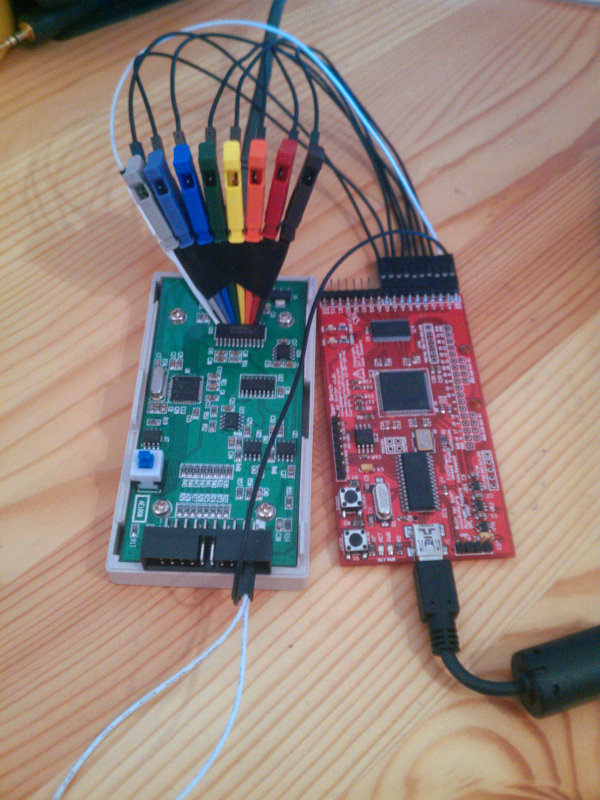Driver Usbee
USBee DX is the ultimate simple, yet powerful, Mixed Signal Oscilloscope, Logic Analyzer, Signal Generator, Protocol Decoder and Analyzer.
USBee DX Overview USB 2.0 Connectivity Packet analyzer, logic analyzer, oscilloscope and signal generator all in one Up to 24MHz Sampling Stream samples to the PC 16 digital channels/ 2 analog channels Protocol Analyzer for USB, I2C, SPI, Async, CAN, I2S, 1-wire, SM Bus, PS/2 andcustom Busses Small, compact and portable Resolve Bugs Faster and Easier The USBee DX Platform delivers the highest level of integration and functionality in the test instrument market. With 2 analog channels and 16 digital I/Os, the USBee DX combines four functions into one; protocol analyzer, logic analyzer, mixed signal oscilloscope and signal generator. Unlike other mixed signal oscilloscopes which charge extra for each serial protocol, the USBee DX includes numerous serial protocols including I2C, SPI, Async, SDIO, 1-wire, I2S, CAN and support even custom protocols. Mixed-Signal Multi-level Protocol Decoding Unique to USBee products, protocols and packets are displayed in human readable packet format, having automatically been translated from HEX to your custom description.
Driver Speedboat Paradise

With a huge sample buffer size using the PC RAM and Advanced Search properties, users can significantly reduce debug time by eliminating chunks of grunt work that would typically chew up man-days or man-weeks of effort, and yet improve bug detection capability. Its portability and low prices allow every engineer or firmware developer to have an USBee DX on their desk.
Windows and Mac Fully Supported The USBee DX Suite platform works seamlessly on Windows XP through Windows 8.1 as well as Mac OS X under Parallels 9 including Coherence mode as seen below. Packet Analyzer Features Simultaneously decode multiple busses to extract the data transferred on the signals I2C, SPI, Async, CAN, 1-Wire, USB, and many other protocols supported Packets can be filtered and searched based on field contents or lack of content PacketPresenter takes the decoded byte streams and formats the packets by breaking out the fields you define Packet data can be exported in a variety of formats including RTF, CSV, TXT, Excel, or Binary file Custom Protocol Decoders and PacketPresenter definitions let you tailor it to your special bus. PacketPresenter Packet Analyzer Supercharging the USBee, the PacketPresenter™ displays the bus traffic that is being transmitted between ICs or system components in a graphical, easy to understand packet format that can be customized to your specific design. With standard logic analyzers, engineers have been accustomed to counting bits, manually decoding protocols, and parsing embedded bus traffic into useable fields. The PacketPresenter does this for you automatically. With the PacketPresenter, counting bits on a logic analyzer is a thing of the past.
Driver Usbaapl64

The PacketPresenter translates standard logic analyzer traces into graphical communication packets that are easy to read and understand. The PacketPresenter saves you time by automatically extracting the protocol information of interest from raw bus traffic and presenting it in a clear and simple format.
You no longer need to count bits or decode waveform traces to find out what your system is saying. Many existing Protocol Decoders understand only a single protocol. The PacketPresenter, on the other hand, is customizable to fit your custom and unique embedded bus protocol using a simple and intuitive configurable PacketPresenter Definition file. And unique to the USBee, the PacketPresenter gives you a detailed look into how the packet communications on your embedded bus relates to the actual voltage-versus-time waveforms of the bus signals. Debugging is performed by viewing and analyzing the PacketPresenter output and relating it back to the logic analyzer waveforms and decoded bus traffic for the various types of busses.

For example, you can see the PacketPresenter display of HDLC communication packets, and correlate that back to the raw byte stream that was decoded from the ASYNC bus, as well as the voltage versus time waveforms of the bus Tx and Rx lines. The waveforms show the activity on the signal lines and the Bus Decoders show the data contained on that bus: Finally, the PacketPresenter parses that data into fields: The PacketPresenter feature runs alongside the existing bus decoders. It takes the output of raw binary data from the bus decoder and parses the stream according to a PacketPresenter Definition File for the intent of displaying the communications in easily understood graphical displays.
Driver Speedboat Paradise
Protocols are defined using a text file, called a PacketPresenter Definition File, which specifies the fields within the protocol and how to display that information on the screen. It is generic enough that you can create your own protocol decoders for your own custom bus types. Each PacketPresenter Definition File correspond to one single bus type, and the incoming bytes from that bus are inputs for the decoding process. This steam of data is called an incoming Data Stream and it is handled by a Protocol Processor. Each Protocol Processor takes a single incoming Data Stream that is broken into Packets, parsed into Fields and either displayed as a field on the screen, ignored, and/or sent to a new Protocol for further processing (as in an N layer protocol). Each Protocol Processor defines how to break the stream into Packets, and how to break the Packets into Fields.
These Fields can then be displayed or sent to another Data Stream for further processing.